It Was the Age of the Wolf Pack
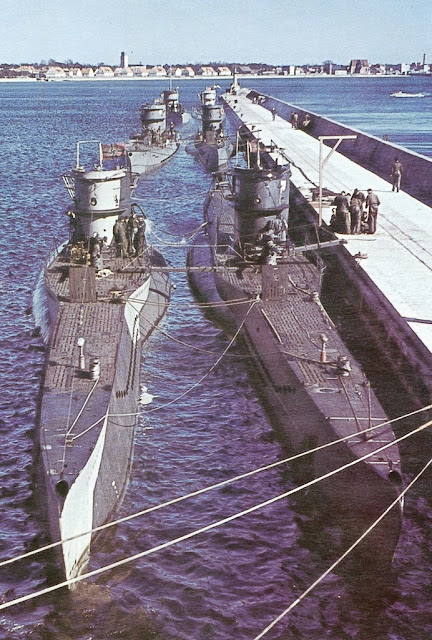 |
| Rare color photograph of Type VIIs in the harbor. |
Introduction
German submarines were the one weapon of war that Germany used successfully from the first day of World War II until the last - and even a little while longer. They were the most successful arm of the German Navy (Kriegsmarine) and were a key part of the German strategy for world domination. They were only contained via costly countermeasures that required vast expenditures by the Allied powers and, at several points, had the potential to turn the entire course of the war to Germany's favor.
 |
| Commander of German U-Boat U-182 |
"U-boat" is the German word for a submarine. So, to a German, every seafaring nation has U-boats. However, in English usage, the term "U-boat" refers solely to German submarines. The Allies had their share of submarines - English, American and Russian submarines all made their mark during the war - but the U-boats had the greatest potential to accomplish strategic objectives.
 |
| World War I surrendered U-boats. |
While submarines go back in history to the middle ages and were used during the American Revolution, they only became viable when technology caught up with them in the 19th Century.
 |
| U-boot U 96, Herbert Kuppisch, the 'Happy Time.' This boat, which was quite successful and only sunk in port at the end of the war, was the subject of the famous 'Das Boot' by Lothar-Günther Buchheim (Lothar-Günther Buchheim, Federal Archive). |
The Confederate Navy pioneered their use during the Civil War, and the French at the same time developed a submarine that did not rely on human power for propulsion. A British engineer, Robert Whitehead, chipped in by developing the first true torpedo.
 |
| German submarine U-9 (1910). |
Germany was interested in submarines along with everyone else, but for some reason, these types of weapons fascinated them. Perhaps it was because the German nation never had a truly dominant navy and was perpetually on the defensive at sea, and submarines are inherently defensive weapons in a strategic sense - they neutralize opposing navies (they can also be considered strategic offensive weapons, of course, by depriving England of food).
 |
| Kapitänleutnant Otto Kretschmer, also known as Otto der Schweigsame (Silent Otto), November 1940 (Tolle, Federal Archive). |
After early attempts in the mid-19th Century did not get very far, the Germans built a couple of submarines in 1890. They built another one in 1908, which was sold to Russia, then built one for their own navy in 1906. These included the first torpedo tubes.
 |
| This picture gives a good sense of the size of torpedoes. |
By 1912, the Germans were installing diesel engines in their submarines, and they ramped up production quickly. At the outbreak of war in August 1914, Germany had 48 submarines either ready to go or under construction, with 29 available for use.
World War I
 |
| A World War I U-boat surfacing |
World War I U-boats were small and barely ocean-going, but the Allies had not learned any countermeasures against them. Thus, the first U-boats were wildly successful, sinking five British cruisers in the first ten weeks of the war. In fact, they were so successful that the Kaiser approved unrestricted submarine warfare around the British Isles, which did away with any kind of notice to civilian ships. This led to the greatest submarine triumph of the war, the sinking of the RMS Lusitania on 7 May 1915. There were 1198 lives lost, including several prominent Americans, and that almost brought the United States into the war two years earlier than it did enter. It was a proper sinking according to the rules of warfare - especially considering that the liner was carrying war supplies against the rules - and it showed the power of the U-boat.
 |
| A World War I torpedo boat crew-member. |
The Germans became frustrated at their inability to win on land, so in early 1917 the government succumbed to the promises of the Admirals and approved unrestricted submarine warfare. Predictably, the United States was not happy and soon declared war for that and a variety of reasons. They instituted a convoy system that limited submarine sinkings and made the submarine attacks less effective. The Germans typically had 18 submarines on station around Great Britain during the war, and they were too small to venture across the Atlantic. When Germany surrendered in November 1918, the U-boat fleet sailed to the British submarine base at Harwich and the U-boats were scrapped or used by Allied navies for a while.
 |
| Different views of a U-boat that had been in tow in 1919 but broke free of its tow line in poor weather. |
Inter-War Years
 |
| A U-boat that has been blown ashore at Falmouth after the First World War. |
The Treaty of Versailles that ended World War I prohibited Germany from having any submarines. Germany was restricted from other explicit military activities as well, such as a military general staff, but they found ways to effectively circumvent all those prohibitions. In the case of U-boats, the German navy set up various front operations in other countries to engage in submarine design and torpedo research.
 |
| U-204. It appears to be in port in Norway. |
Looking back, it is amazing to see how the Germans developed airplanes and tanks in Russia, torpedoes in Sweden and submarines in the Netherlands despite the restriction of Versailles, but they got away with it more or less clandestinely. After the accession of the war-monger Adolf Hitler as Fuhrer of Germany, the British began to realize the danger and negotiated the Anglo-German Naval Agreement of 1935. This permitted Germany legally to have 35% as much tonnage as the British Royal Navy, which was a violation of the terms of the Treaty of Versailles but simply reflected reality.
 |
| Admiral Horthy of Hungary and Hitler observing Kriegsmarine U-Boats, 1938. |
The Germans actually hadn't waited for the treaty. They began building U-boats immediately upon their accession to power in 1933. They launched their first U-boats, in fact, in April 1935, two months before the treaty. The British were in the position of firefighters who concede that they can't save the house, so they draw a ring around it to prevent the fire from spreading. They did this by negotiating a new naval agreement to replace the one treaty the Germans previously had violated. It was just another form of appeasement, and it didn't work. The Germans officially notified the British of their submarine program on April 25, 1935, and frantic negotiations produced another pointless naval agreement that the Germans ignored as far as submarines were concerned and evaded by stealth in terms of surface ships.
 |
| A cross-section of Type-IXc U-boat 505, which was captured in June 1944 and survives in a museum in Chicago, Illinois. |
In terms of surface ships that could be easily observed and inspected, the treaty put strict limits on German naval construction which the Germans had to observe to some extent. Hitler was not too enthused about a surface fleet anyway, and German shipbuilding resources were limited. Therefore, the German evasions with the battleships and cruisers were only at the margins - unlike with the U-boats.
 |
| U-50 crew. This is 12 March 1940. They went out on their next patrol and were sunk, 6 April 1940, in a North Sea minefield as they were returning home. Everybody in this picture was killed. (Federal Archive). |
They built battlecruisers with slightly larger tonnages than allowed by the treaty through various deceptions and things like that, but otherwise largely abided by the terms of the treaty with the surface fleet - which cloaked the fact that their U-boat construction wildly flouted the treaty's terms. While German surface warships were comparable in quality to British warships, there were never enough of them to make a strategic difference - which was the point of the treaty from the British perspective. The U-boats, however, were a different matter altogether.
U-boats were cheaper and quicker to build than large surface ships, which required heavy armament, armor, larger crews, and expensive gear such as the new radar sets. They were known to be effective from World War I experience, while German surface ships in that conflict had a much spottier record. Consequently, Germany put most of its naval construction resources during the late 1930s into its submarine force rather than a surface fleet. Besides, Hitler was known to ask often about how many units his commanders had built, and it was more advantageous for them to tell him that many units had been built as opposed to fewer units, regardless of size or capability. Thus, different pressures within the Reich's military establishment and economy led to the construction of smaller U-boats than may have been optimal for the war as it ultimately developed. Larger seagoing U-boats would have been more optimal for the long voyages across the Atlantic and around Africa to the Indian Ocean that the war required. However, in the end, the size of most U-boats was adequate for the tasks they were called upon to do, if just barely so.
 |
| Launching of a German submarine class VII B, in the Krupp-Germania-Werft shipyard in the port of Kiel. |
World War II
 |
| 1939 U-boat. |
Germany began the war with 57 U-boats, many of which were small and short-range. These smaller submarines were good for minelaying and short excursions, but they were not ocean-going boats. Mines were an effective weapon against British shipping, especially early in the war, so the impact of minelaying U-boats should not be underestimated.
 |
| The U-73 was a Type VIIB U-boat of the German Kriegsmarine during World War II. She was laid down by Bremer Vulkan of Bremen-Vegesack, Germany as 'Werk' 1 on 5 November 1939, launched on 27 July 1940 and commissioned on 30 September of the same year under Kapitänleutnant (Kptlt.) Helmut Rosenbaum. U-73 carried out 15 patrols between early She was sunk by two US warships, USS Woolsey and USS Trippe, off the North African coast on 16 December 1943 at 36°7′N 0°50′ECoordinates: 36°7′N 0°50′E. It looks like good morale on this boat. |
Throughout the war, as a rule of thumb divide the total number of U-boats available by three, and that will give you the approximated number of them that were on patrol: one-third would be on patrol, one-third would be traveling to or from its station, and one-third would be in port for restocking and refit. Thus, it was noted early on by the Germans that in the first year of the war, they often only had as many boats on their stations - 18 - as had been the case during World War I.
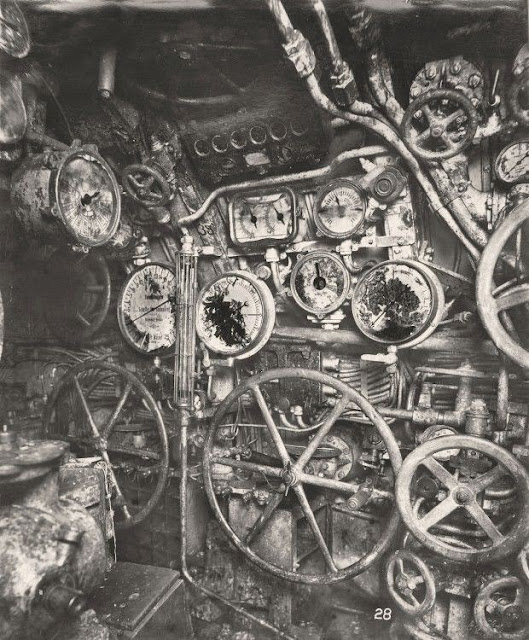 |
| U-Boat 110 after salvage. |
From day one of the war, the Germans relied upon a three-pronged offensive at sea: U-boats, surface raiders of various types, and aircraft. The latter two, though, were spent forces by the final year of the war. U-boats remained effective from the first day of the war until the final day of the war.
 |
| U-35 damaged after being rammed by the Graf Spree in 1938. |
The Kriegsmarine, of course, knew all about the invasion of Poland, so it sent its ships to sea before hostilities broke out on September 1, 1939. When Britain and France declared war on 3 September, several U-boats were in position and waiting.
 |
| An unusual kill for a U-boat. 1 September 1943. (Federal archive). |
The SS Athenia, a passenger liner, left Glasgow, Scotland for Montreal on 1 September, a bold act in light of the international situation, and U-30 commanded by Oberleutnant Fritz-Julius Lemp caught sight of her and within hours of the order to commence hostilities and sent her to the bottom. This hit the next day's newspapers alongside the declaration of war and caused a mild sensation. The war was still being conducted according to "civilized" rules which forbade bombing of cities and sinking of passenger liners, so this sinking caused all sorts of controversy about its "legality." Such "rules" would be forgotten within months.
 |
| U-boat pens at Lorient, France. |
The first impulse of the British was to organize submarine-hunting groups to seek out and destroy submarines. This, in fact, was done for a while, but it was an utter failure that just exposed the British ships to submarine attack. The British carrier Courageous was a victim of U-29 on 17 September while pursuing this mistaken tactic.
 |
| 1941- German U-Boat hero Lieutenant-Commander Joachim Schepke. Seventh recipient of the Knight's Cross of the Iron Cross with Oak Leaves. Don't ever disturb a U-boat commander until he's had his morning coffee and cruller. |
The Germans scored another huge success in October when Günther Prien in U-47 audaciously evaded British defensive nets and entered the protected British harbor of Scapa Flow. This, somewhat ironically, was where the entire German surface fleet of World War I had been sunk. Prien quickly added the British battleship Royal Oak, which was at anchor, to the remnants of the German fleet (much had been salvaged) at the bottom.
 |
| 2nd January 1942: A U-boat commander hunts for his first kill (Tolle, Federal Archive). |
Admiral Karl Dönitz (Doenitz) led the U-boat assault under the command of Grand Admiral Eric Raeder. Doenitz had been instrumental in the pre-war years in designing the standard U-boat, building up the U-boat fleet, and developing tactics and strategy. Doenitz had all the U-boats out at sea during the early days of the war, but they soon needed to return to port for rest and restocking. The order to Doenitz, in charge of U-boats, went out on 15 August 1939, and it was very clear: put to sea at once.
 |
| U-133. |
The fleet thus was on station once the war was declared, and this paid off when it got a quick kill. The SS Athenia had left Great Britain right before war was declared. This turned out to be an unwise move when it was sunk by U-30 under Oberleutnant Fritz-Julius Lemp on the afternoon of 3 September, the very day that England declared war. Then, after an initial burst of activity, the next few months of the war were fairly quiet at sea as the boats came back in to re-stock. After that, Hitler's adventurism in Scandinavia (Operation Weserübung) kept many submarines out of the sea lanes. This turned out to be helpful because it revealed problems with the U-boats' torpedoes. Once these problems were corrected, the U-boats were deadlier than ever. Ships hit and sunk during 1939 were as follows:
1939
Sep (52 ships sunk)
Oct (37)
Nov (30)
Dec (47)
166 ships total were hit in 1939.
 |
| A German U-boat enters a Norwegian harbor in July 1942 to a welcome party of German officers and soldiers. |
Dönitz instituted a new tactic called the Rudeltaktik ("Wolf Pack"). This was different than tactics used during World War I when U-boats went out and operated silently on their own in pre-assigned spots. This new tactic proved quite effective at times. Under Rudeltaktik, submarines would form a picket line across the known convoy lanes. Once one of the submarines spotted ships, it would call over the others and they would all attack the convoy.
 |
| Another one bites the dust. |
Dönitz felt that 300 submarines would be enough to cut off all supplies to England. However, Raeder was a proponent of big ships such as battleships and aircraft carriers, and he had Hitler's ear. Hitler ordered the big ships, which all turned out to be fairly useless, built. Dönitz did not get his 300 U-boats until much further on in the war, when it was too late to affect the outcome. The U-boats managed some sinkings through the spring of 1940, but nowhere near a decisive amount.
The First Happy Time
 |
| U-boat crew at sea during the First Happy Time. |
The German defeat of France in mid-1940 changed the entire equation of U-boat warfare. Possession of the French coastline, which the German navy never acquired during World War I, shortened the distance that the U-boats had to travel to the sea lanes by hundreds of miles.
 |
| The Lorient, Brittany, U-boat pens. |
It also eliminated various choke points where the Allies could patrol and disrupt the U-boats' comings and goings from their ports. The Bay of Bengal became a German lake, and early in the war U-boats could sail across it on the surface and only submerge further out to sea.
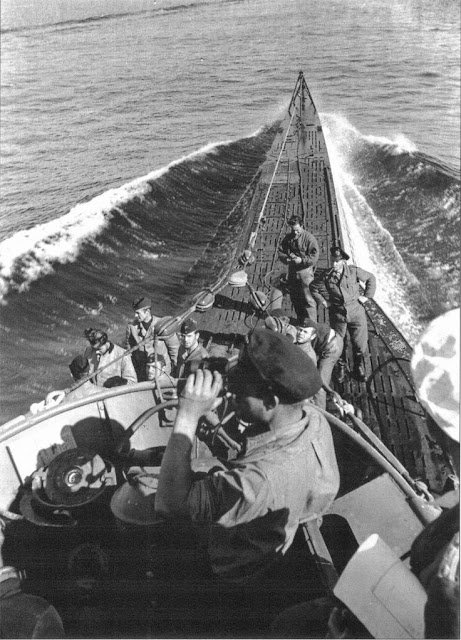 |
| German U-Boot U-100 on final approach to the German base at Lorient, France in Sept 1940. While nobody looks too concerned about a visit from the British, note that the lookout is keeping a sharp eye to the north - and England. |
This effectively increased the size of the German U-boat fleet. Dönitz recognized the opportunity and built submarine bases on the coast at Lorient and elsewhere. The U-boat base on the Keroman peninsula is huge, capable of sheltering thirty U-boats at once and remains largely intact. Dönitz had his headquarters right across the bay. Ship totals for 1940:
1940
Jan (58 ships sunk)
Feb (54)
Mar (26)
Apr (11)
May (17)
Jun (67)
Jul (43)
Aug (66)
Sep (64)
Oct (72)
Nov (36)
Dec (50)
564 ships total were hit in 1940.
 |
| A U-boat being piped ashore. |
The period from June 1940 to February 1941 was known by the German U-boat men as the "First Happy Time." This was a period when the U-boats enjoyed great success, with the boats sinking on average 7 ships per cruise.
 |
| Late on the afternoon of April 27th, 1941, Erich Topp in U-522 found a big target at about 17 degrees west longitude (near Iceland): the 10,100-ton British freighter Beacon Grange, sailing alone. Topp attacked submerged, firing all four bow tubes (which seems like overkill). The crew broadcast the submarine alarm SSS, then took to the lifeboats. The corvette Gladiolus rescued 41 of the crew two days later. |
for this success included the first run of success after the fall of France, when the British were not prepared for U-boats right at their doorstep, shock by the British at losing French as an ally with her navy helping to patrol the seas, and the fact that Britain had not yet fully developed sonar (called ASDIC by the British) and radar (which could detect submarines on the surface).
 |
| This was taken in March 1941. |
The period ended when three of the most successful German U-boat captains, Günther Prien, Joachim Schepke and Otto Kretschmer, either died (Prien and Schepke) or were captured in March 1941. U-boat sinkings during 1941:
1941
Jan (15 ships sunk)
Feb (47)
Mar (50)
Apr (48)
May (66)
Jun (65)
Jul (21)
Aug (32)
Sep (60)
Oct (51)
Nov (17)
Dec (28)
500 ships total were hit in 1941.
The period directly after the First "Happy Time" wasn't too bad for the U-boats, either. However, the number of ships sunk per U-boat cruise was dropping, and the British were beginning to tighten up their convoy system and other countermeasures.
The Second Happy Time
 |
| A U Boat is resupplied with torpedoes from another U Boat whilst in the Caribbean in early August 1942, during Operation Paukenschlag. Resupply U-boats were known as "milch cow" boats. |
The Second Happy Time followed in 1942, from January to August of that year. This was right after the United States entered the war, and it might seem counter-intuitive that this would be a boon to the U-boats - but it was. Hitler authorized Operation Paukenschlag (Drumbeat), which was an order for U-boats to cross the Atlantic and patrol off the coast of the United States. Hitler dreamed at various times of bringing the war to the American mainland, but he never did. However, he came as close as he could with this operation Paukenschlag.
 |
| Kriegsmarine Lieutenant - 1942. |
The Americans were as unprepared for the U-boats as the British had been during the first Happy Time, and for the same reasons. The U-boats went wild, sinking freighters within sight of cities along the U.S. coast with few losses of their own. With 609 sinkings, the U-boats only lost 22 of their own numbers. This Second Happy Time only ended when the Americans introduced tight coastal convoys, air patrols, and other costly counter-measures. U-boat successes during 1942:
1942
Jan (66 ships sunk)
Feb (82)
Mar (99)
Apr (89)
May (146)
Jun (146)
Jul (109)
Aug (131) Sep (116) Oct (120) Nov (142) Dec (76)
1322 ships total were hit in 1942.
Even after the U-boats were withdrawn from the American coast, they continued racking up huge numbers for a while. In fact, November 1942, during the Atlantic crossings in support of Operation Torch, the invasion of North Africa, was among the U-boats' best of the entire war. U-boat sinkings were essentially matching new ship construction by the Allies, which was a good performance, but what was happening was that the Allied merchant fleet was slowly being weeded out of its older, slower, more vulnerable ships and being replaced by newer, faster and bigger ships. While the U-boats weren't losing the Battle of the Atlantic, they weren't winning it, either.
Weather Station Kurt
The U-boats did things besides sink ships. They also invaded North America.
 |
| Inflatable rubber rafts on the after deck of German U-537 in Martin Bay, Labrador, Newfoundland (now Canada) on 22 Oct 1943. The rafts were used to take pieces of Weather Station Kurt ashore to the Hutton Peninsula. (German Federal Archive). |
U-boats were excellent for clandestine missions to the Americas. A U-boat landed German agents on Long Island, New York, for instance. But there was another, greater achievement.
 |
| Weather Station Kurt on display in Canada, 2007. |
In October 1943, U-Boat 537 landed an armed party in Labrador and stayed there for over 24 hours. They installed a weather station and repaired their submarine.
Their installation worked, and it was so well hidden that it wasn't discovered again until 1977. Never thought the Germans had armed forces on the western shores of the Atlantic who completed a mission and weren't caught? They did indeed.
Sudden Defeat
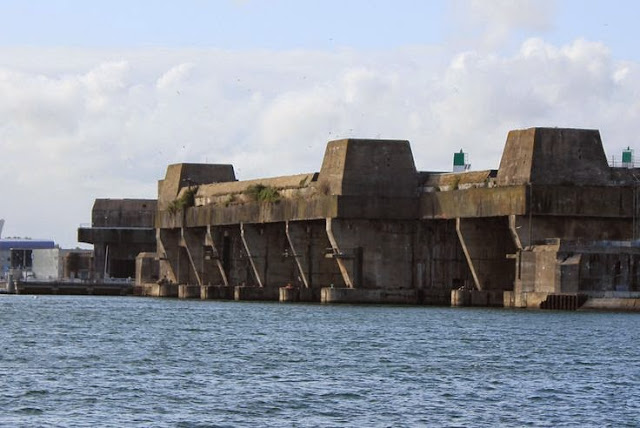 |
| Keroman Submarine Base (German U-boat base) located in Lorient. |
Things came to a climax early in 1943. March 1943 sinking totals were high, and with all the sinkings, supplies were running low in Great Britain. While most thought that the Allies were finally starting to win the war, in fact, this was the time of greatest anxiety for Winston Churchill and others who were privy to the sinkings figures. If things had continued as they were, or the Germans had even stepped up their game a bit, Great Britain might have started seeing starvation and an inability to stock up American troops in preparation for the eventual invasion of France.
 |
| Depth charge attack in the middle of a convoy. |
However, suddenly troubling signs began appearing for the U-boats. Sinkings of U-boats, never previously a serious problem, suddenly began to rise. While March was a good month for Dönitz, April was completely the opposite: the U-boats sank only 39 ships while losing 15 of their own number.
 |
| A survivor of German submarine U-175 is led below decks by crew members of USS Dwain, April 10, 1943. He did his duty and survived. You are looking at the luckiest man in the world for the day of 10 April 1943. |
May was even worse, with complete debacles in attacks on convoys ONS 5 and SC 130 (there were different codes for convoys heading east and west). Dönitz, losing U-boats left and right, had to call off the attack for months. They never regained their old form. U-boat sinkings of merchantmen during 1943:
1943
Jan (49 ships sunk)
Feb (88)
Mar (131)
Apr (57)
May (49)
Jun (27)
Jul (59)
Aug (30)
Sep (25)
Oct (31)
Nov (16)
Dec (17)
579 ships total were hit in 1943.
 |
| A deck gun on the only U-boat sunk in the Gulf of Mexico. |
At this point, Allied shipbuilding began vastly outstripping sinkings. The Allies were building up their merchant fleet with better ships while no longer losing as many of the older ones. The reasons for the Allied victory are murky, but they include better Allied convoy protection, improved Allied technology, and increased Allied air patrols. No longer could the U-boats cruise out into the Bay of Bengal on the surface, even at night: they were likely to suddenly be hit with a Leigh Light from a circling British Hudson and come under depth charge attack. British Coastal Command sank an astounding number of U-boats in 1943, 90 all told during the year. In addition, with the success of the Torch landing in early November, many escorts were shifted from the protection of troop transports and naval vessels near North Africa back to the Atlantic. Improvements in radar and sonar also paid off.
 |
| Mass production of U-boats in a German shipyard, 1943. |
Sinkings in 1944:
1944
Jan (20)
Feb (28)
Mar (22)
Apr (12)
May (17)
Jun (22)
Jul (25)
Aug (37)
Sep (15)
Oct (10)
Nov (11)
Dec (25)
244 ships total were hit in 1944.
After that, the U-boats tried various tactics to remain a threat. However, during the final four months of 1943, when Dönitz - now in charge of the entire Kriegsmarine because Raeder had been fired due to the failure of the surface fleet - tried again. U-boat losses now, however, became even higher than Allied sinkings. Various palliatives were tried, including fitting U-boats with better antiaircraft guns and orders to fight air attacks, but these tactics all failed. The true hope of the U-boat commanders was improvements in technology so that they had better U-boats which could remain submerged and still run throughout their missions. However, these new designs, while extremely promising, but they never entered service in enough numbers to make any kind of difference.

U-boat successes picked up slightly in December 1944 and continued at a slightly higher pace for the remainder of the war. This was due to the introduction of a small number of the new U-boats and some last-gasp risk-taking by the U-boat commanders. There were high hopes for the new
Type XXI U-boats and their revolutionary propulsion systems, with the astonishing figure of 118 of them built in the closing days of the war. However, the Type XXI suffered from serious teething and manufacturing problems that prevented them from sinking any Allied vessels. Thus, Type XXI U-boats, despite having a huge influence in the post-war era, were a non-factor in World War II.
 |
| A surviving Type XXI U-boat. |
Ultimately, all of the U-boats were either scuttled (200 of them) or appropriated by the Allies after the German surrender in May 1945. The Allies disposed of the captured U-boats in Operation Deadlight, which allocated 10 U-boats to each of the major sea powers (Great Britain, the Soviet Union, and the United States - the French were excluded from the spoils, though they had some captured U-boats sitting in their ports which they quietly took for themselves). According to the terms of Operation Deadlight, the remaining U-boats were sunk in the Atlantic off the coast of Ireland.
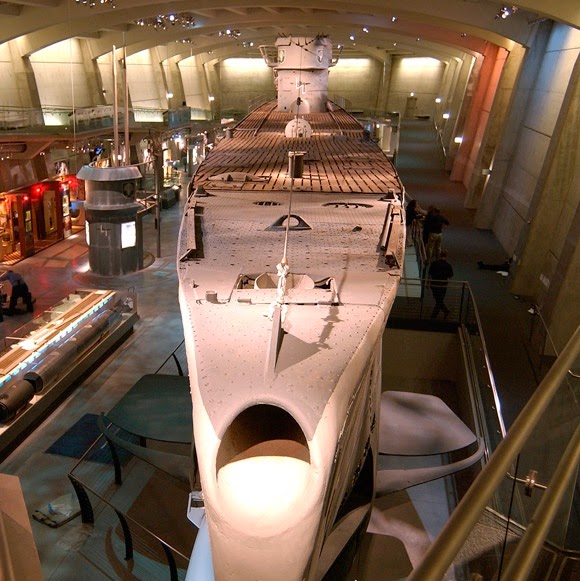 |
| A captured U-boat on display in Chicago, Illinois. |
Several U-boats were on patrol or missions to Japan when the surrender order came through. Some of those took several weeks to finally accept the inevitable and put into port. While there are recurrent rumors that various top Germans escaped the fall of Germany in U-boats, all World War II U-boats have been accounted for, and there is no evidence that any officials tried to escape. If they did, none of them got very far.
 |
| A surrendered U-boat in the Thames 1945. |
Conclusion
 |
| U Boat Memorial, Kiel, Germany. |
The U-boats were a true menace, especially during the middle years of the war. Churchill considered them the greatest threat faced by Great Britain during the war. The Battle of the Atlantic started off reasonably honorably (Doenitz, in charge of the U-boats, only got ten years at Nuremberg, he'd have been executed if he had deviated too far from the rules of war), but slowly descended into savagery due to the high stakes and frustrations of combat. There were tales of great brutality on both sides, with frustrated and fanatical U-boat commanders machine-gunning survivors of their sinkings, Allied ships leaving U-boat survivors to perish in the sea, and the like, but these were isolated incidents and perhaps apocryphal in some instances. The bottom line is that, just as with the Kriegsmarine's surface fleet, the U-boat fleet failed in its mission and had slid into irrelevancy by the final two years of the war.
2021
















































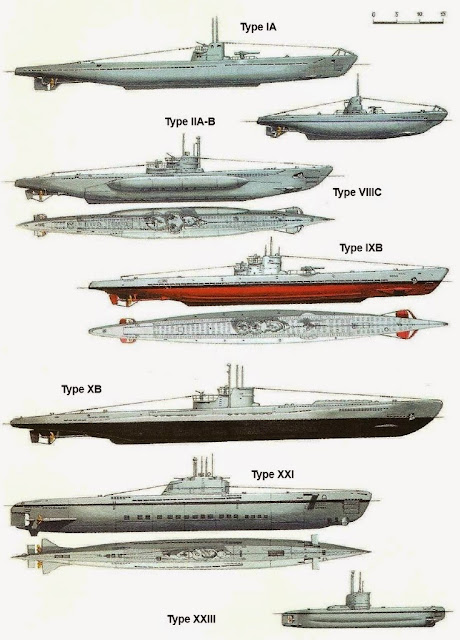

Naval warfare is brutal they are at sea no were to run or hide but sailors and commanders perform clean battles from both sides Navy War is based on duty honor and military ethics as they perform in academics and experience.
ReplyDelete